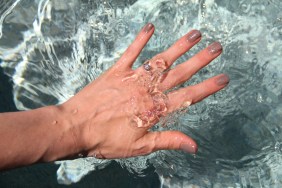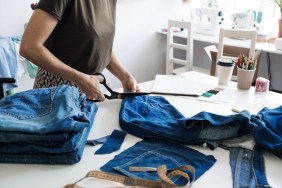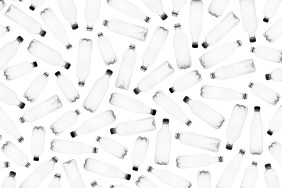Donna DiStefano: It is comfort with elegant details. I’m a fan of great accessories. When I lived in Italy, one thing that struck me was the boys would wear jeans and Ts, however, their shoes and belts were impeccable. My shoes are from a shoemaker in Rome who works by hand with the finest leather. I love Catherine Malandrino because her dresses are light and easy. I think of Valentino, Givenchy, and McQueen as the holy trinity of fashion. I never wear those super high heels, always a fan of kitten heels and comfort. I am a punk rock, and rock ‘n’ roll girl with tastes that are classical. When I think of it, my Renaissance heroes were also rebels and quite chic! And I wear Harley Boots in my workspace!
C: Are there any creative goals in the near future?
DD: The men’s line, Victorian, New York, Rocker. Also, tiaras and crowns. More down the road; creating an after school program for underprivileged NYC kids who are in need of a creative outlet and are interested in jewelry making.
C: Describe the general process you go through to design and realize a piece of jewelry?
DD: I read a lot and get inspired by different periods in time. I look at paintings and wonder how they selected their jewels (gifts, mourning, talisman, medals of honor, etc) and I think about how those periods in time influence us today. Sometimes I sketch. But some of my best pieces were realized at the bench through trial and error, by rolling out sheets of gold and creating decorative elements.
C: What does your brand say about you?
DD: The pieces tell a story. They are conversation pieces that inspire historical references. The techniques I use are thousands of years old. These are things I like to talk about, learn about, and I think most of my clients are drawn to me for that reason.
C: Walk me through the process of starting your brand?
DD: I had a company at the tender age of 20. Back in the 80s I sold to Pat Field and Saks Fifth Avenue nationwide. I always designed collections that were tied to a charity, and I wrote my own press releases. After burning out in 1989, I shifted gears and moved to Italy to get my head together. What I learned was, I really, really love jewelry. So I came back and dove in again. I took a job at the Metropolitan Museum as Senior Goldsmith responsible for the jewelry reproductions sold worldwide. After leaving the Met in 1994, I started my own company, based on handmade, precious pieces, very much inspired by the Renaissance.
C: What is the green process of Gold?
DD: Sustainable gold is refined, not mined. That means a refinery will melt existing gold that is already on the planet. Metal mining is the number one toxic polluter in the United States, responsible for 89% of arsenic releases, 85% of mercury releases, and 84% of lead releases in 2004. Another staggering example is 120,000 tons of toxic waste spilled from the Baia Mare gold mine in Romania in 2000, contaminating the drinking water of 2.5 million people and killing 1,200 tons of fish.
C: How did you first learn about the effects of jewelry in the environment?
DD: I read. I have been committed to using recycled precious metal for more than 15 years. Always looking for ways to minimize the impact of goldsmithing on the planet, I choose to use pure gold supplied by refiners rather than miners. Mining creates literally tons of environmental waste. There is plenty of gold already in circulation, and by using recycled gold we can diminish our impact on the environment just a little bit more. There is a dirty side to the beautiful jewelry industry that no one talks about. Jewelry has been a form of personal adornment throughout humankind. Gems and precious metals are natural gifts from nature. It’s greed that makes them unsavory accessories. If you investigate before your purchase, you can wear jewelry that is truly beautiful.
C: How do you know if a gem or diamond is dirty or has blood on it?
DD: There are wonderful organizations like the Diamond Empowerment Fund and the Diamond Development Initiative. I urge people to support these groups because they are the ones who are really trying to put an end to blood diamonds. Just visit their websites, watch some of the videos. It’s important to educate yourself. Canada and Botswana have very good reputations for clean diamonds.
C: Explain the level system on your site?
DD: My levels are rated by me: A, B, C, or D.
- A: These are natural gemstones purchased from a fair trade vendor who tracks the gem material from the mine to the cutting factory. Level A gemstones are accompanied by written verification of their country of origin and are mined and cut by fairly compensated workers with great consideration given to the environmental impact of mining and gem cutting.
- B: These are natural gemstones that can be traced to the country of origin. Our vendors have written agreements in place that require fair labor practices in the gem cutting facilities where these gemstones are polished and faceted.
- C: These are natural gemstones procured from reputable vendors who follow fair trade guidelines, but do not provide written verification of fair trade protocols. Any enhancements to the gemstones are fully disclosed.
- D: These are gemstones that have been in the Donna DiStefano inventory prior to 2008. While many may be fair trade, we are unable to verify the chain of custody for gemstones procured before establishing our fair trade initiative.
C: How can an average consumer educate themselves about the industry and which jewelry is green and will not hurt your conscience?
DD: Ask your jeweler if their gold is sustainable. Also visit sites like www.nodirtygold.org and check out this piece on 60 minutes.
Please visit: donnadistefanoltd.com
Gold Goes Green: Donna DiStefano
-
Gold Goes Green: Donna DiStefano

-
Gold Goes Green: Donna DiStefano

-
Gold Goes Green: Donna DiStefano

-
Gold Goes Green: Donna DiStefano

-
Gold Goes Green: Donna DiStefano

-
Gold Goes Green: Donna DiStefano

-
Gold Goes Green: Donna DiStefano

-
Gold Goes Green: Donna DiStefano

-
Gold Goes Green: Donna DiStefano

-
Gold Goes Green: Donna DiStefano

-
Gold Goes Green: Donna DiStefano

-
Gold Goes Green: Donna DiStefano

-
Gold Goes Green: Donna DiStefano

-
Gold Goes Green: Donna DiStefano

-
Gold Goes Green: Donna DiStefano









